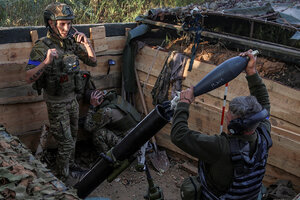Can Ukraine avoid a ‘forever war’ against Russia without talks?

Ukrainian service members fire a mortar toward Russian troops at their position near a front line, amid Russia's attack on Ukraine, in the Zaporizhzhia region, Ukraine, Sept. 4, 2023.
Oleksandr Ratushniak/Reuters
London
The optics spoke of shoulder-to-shoulder Western unity against Russia’s assault on Ukraine. But last week’s European foreign ministers’ meeting was most significant for an unscripted eruption of tension between Ukraine and its key allies over a core aspect of the conflict.
How to prevent it from becoming a “forever war.”
And in the longer run, whether and how a diplomatic resolution might be found – an especially agonizing prospect for Ukraine, given the huge price it has been paying for its resistance.
Why We Wrote This
If Ukraine’s counteroffensive bogs down in stalemate, Kyiv will be pressured to negotiate with Moscow to avoid a “forever war” that its allies would likely not sustain. Ukraine needs decisive battlefield success to make such negotiations palatable.
The strain has been intensifying since the launch of Ukraine’s long-planned counteroffensive in June, and its initially slow progress in overcoming deeply entrenched, heavily mined Russian positions in the east of the country.
It was thrust into the open at the European ministers’ meeting by media reports quoting unnamed U.S. and Western officials as criticizing Ukraine’s battlefield tactics.
Prompted for comment by reporters, Ukrainian Foreign Minister Mytro Kuleba did not mince his words. “I would recommend all critics to shut up,” he retorted, “to come to Ukraine, and try to liberate one single centimeter by themselves.”
Washington moved quickly to reassure Kyiv. The day after Mr. Kuleba’s remarks, the National Security Council spokesperson said Ukrainian forces had made “notable progress” in the previous few days against the second line of Russia’s defenses.
Still, the outcome of fighting over the next eight weeks could be decisive when it comes to choosing how to address the next stage of the war. It may not prove easy to match Kyiv’s priorities with those of Washington and Ukraine’s European allies as they seek to agree on a strategy.
On one aim, the allies are united behind Kyiv: to see Ukraine’s counteroffensive make as much headway as possible before heavy rain and plummeting temperatures, likely beginning in November, make significant advances impossible.
But a major breakthrough, dramatically recasting the conflict in Ukraine’s favor, is currently looking unlikely.
And if that doesn’t happen, the question facing Ukraine and its allies will be, what next?
For Ukraine, the answer is straightforward. The best way to bring the war to an end would be for the allies to redouble their stated commitment to Ukraine’s “sovereignty and territorial integrity.”
And to commit to providing the weapons that Ukraine needs to prevail.
Because although huge quantities of Western weapons have kept Ukraine in the fight, many of them have been delivered piecemeal.
Kyiv is still pressing for two kinds of hardware that Western military analysts say are essential to the counteroffensive: more advanced mine-clearing equipment, and longer-range American ATACM tactical ballistic missiles, allowing Ukraine to target Russian supply lines and strike targets in occupied Crimea.
Yet the reason for the sometimes halting delivery of weapons underscores the difference between the political calculus behind the Biden administration’s Ukraine strategy, and Kyiv’s approach.
U.S. President Joe Biden led an unprecedentedly united allied response to Russian President Vladimir Putin’s initial invasion. He has vowed to back Kyiv “for as long as it takes.” But he has also been keeping a wary eye on Mr. Putin.
From the outset, the White House has been worried about breaching the Russian leader’s presumed “red lines” and provoking him to widen the conflict further. That has had the effect of slowing some weapons deliveries.
In Europe, those U.S. allies geographically nearest to Russia – Poland and the Scandinavian countries – share Ukraine’s view that this has risked playing into Mr. Putin’s hands, diverting attention from the fundamental need to push back the invaders. But some major European states, like Germany and France, seem to share Mr. Biden’s worries.
If the battlefield stalemate persists into 2024, Ukraine could well face an even more unpalatable prospect: that pressure will build for a diplomatic resolution, and a deal that would leave Russia in de facto control of the parts of Ukraine it has taken over.
So far, only a scattering of Western voices – most prominently, former French President Nicolas Sarkozy – has broached that scenario publicly. They have been squelched by allied governments.
But that, the Ukrainians worry, may only be because negotiations are so clearly unrealistic at the moment.
Kyiv will be reassured, for now, that the European foreign ministers reaffirmed their commitment to the peace plan announced last year by Ukrainian President Volodymyr Zelenskyy – which calls for a full withdrawal of all Russian troops and a special tribunal to prosecute alleged Russian war crimes.
Yet those terms, of course, are nonstarters for Mr. Putin, and will remain so unless his forces in Ukraine suffer major setbacks that threaten possible defeat.
That is the goal that Ukraine is still aiming for, which is why Kyiv remains insistent that the allies’ surest route to a diplomatic exit is to provide Kyiv with the range of weaponry it needs to effect a major change on the battlefield.
Red lines or no red lines.

